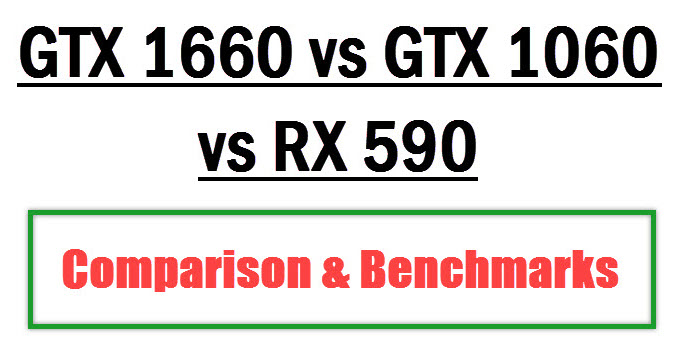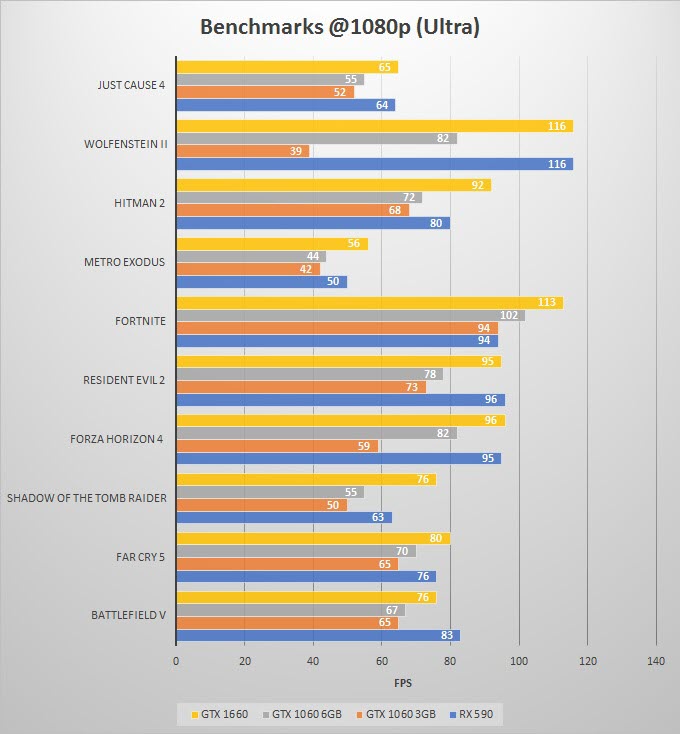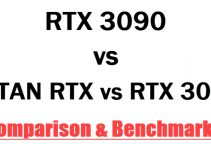GeForce GTX 1660 is the younger brother of the GTX 1660 Ti and is the second card in the GeForce GTX 16 series from Nvidia. Just like GTX 1660 Ti, it is also based on the Turing GPU architecture and is said to be the direct replacement of GTX 1060, especially the 3GB variant of GTX 1060. However, the card is more powerful and can easily fight against the 6GB GTX 1060, and the Radeon RX 590, which is a mid-range graphics from AMD, and an improvement over the older RX 580.

GTX 1660 is also a budget mid-range card and is geared more towards budget-conscious mainstream gamers who mostly game at 1080p. It is also very competitively priced by Nvidia and there are various models available for it from different graphics card manufacturers. So, if you want to know how much performance, value, and features this card offers over its major rivals then here I am going to tell you about it.
GTX 1660 vs GTX 1060 vs RX 590 Comparison
Here is a comparison between GTX 1660, GTX 1060 (3GB / 6GB), and RX 590 graphics cards, based on their specifications, performance, pricing, power consumption, and features.
GPU Architecture
GTX 1060 is based on the Pascal GPU architecture, while GTX 1660 is built on the newer and advanced architecture, which is Turing. On the other hand, Radeon RX 590 is an AMD card and is built on Polaris GPU architecture. The 3GB variant of GTX 1060 comes with 1152 CUDA Cores, 6GB GTX 1060 has 1280 CUDA Cores and the newer GTX 1660 comes with 1408 CUDA Cores.
Radeon RX 590 comes with 2304 Stream Processors, which are very different from CUDA Cores because Nvidia and AMD graphics cards use completely different technologies and internal architecture. CUDA Cores and Stream Processors cannot be compared with each other when determining performance. Below you can find out about the difference between CUDA Cores and Stream Processors.
Must Read: CUDA Cores vs Stream Processors Difference
| GTX 1660 | GTX 1060 3GB | GTX 1060 6GB | Radeon RX 590 | |
| GPU Chip | TU116 | GP104 / GP106 | GP104 / GP106 | Polaris 30 |
| GPU Architecture | Turing | Pascal | Pascal | Polaris |
| Fabrication Process | 12nm | 14nm | 14nm | 12nm |
| CUDA Cores / Streaming Processors | 1408 CUDA Cores | 1152 CUDA Cores | 1280 CUDA Cores | 2304 Stream Processors |
Memory [VRAM]
All the Nvidia graphics cards here come with 6GB GDDR5 memory having 192-bit interface, and offering a bandwidth of 192 GB/s. However, GTX 1060 is also available in a 3GB GDDR5 memory variant, that has a lesser number of CUDA Cores compared to the 6GB variant of it. Lately, Nvidia has also introduced GDDR5X memory in the newer models of GTX 1060 6GB, which makes only a slight performance increase, but the benefit of GDDR5X memory is that it can be overclocked to higher frequencies than the GDDR5 one. On the other hand, Radeon RX 590 comes with 8GB GDDR memory having 256-bit interface, and offers the highest bandwidth here, which is 256 GB/s. The memory speed for all these cards remains at 8Gbps only.
Must Read: GDDR5 vs GDDR5X vs GDDR6 vs HBM2 Memory Comparison
| GTX 1660 | GTX 1060 3GB | GTX 1060 6GB | Radeon RX 590 | |
| Memory Size | 6 GB GDDR5 | 3 GB GDDR5 | 6 GB GDDR5 / GDDR5X | 8 GB GDDR5 |
| Memory Interface | 192-bit | 192-bit | 192-bit | 256-bit |
| Memory Speed | 8 Gbps | 8 Gbps | 8 Gbps | 8 Gbps |
| Memory Bandwidth | 192 GB/s | 192 GB/s | 192 GB/s | 256 GB/s |
Features
When it comes to features, then all of these cards support DirectX 12, OpenGL 4.5, Vulkan, OpenCL and are VR Ready cards. Also, all of these cards support hardware based H265/HEVC and 4K H264 Encoding and Decoding for Video Editing and Rendering.
When it comes to variable refresh rate technologies to reduce screen tearing in games, then GTX 1060 and GTX 1660 supports G-Sync, while Radeon RX 590 has got FreeSync for it. Moreover, Radeon RX 590 is the only card here that supports a multi-GPU setup using CrossFire/mGPU, while GTX 1060 and GTX 1660 lack multi-GPU support as they are not SLI capable.
Features that are exclusive to GTX 1660 Ti include Dedicated FP16 Cores, Adaptive Shading / Motion Adaptive Shading (MAS) / Content Adaptive Shading (CAS), and a new NVEC Encoder that delivers 15% improved efficiency over prior-generation Nvidia graphics cards, and is optimized for Open Broadcaster Software (OBS).
| GTX 1660 | GTX 1060 3GB | GTX 1060 6GB | Radeon RX 590 | |
| DirectX | 12 | 12 | 12 | 12 |
| OpenGL | 4.5 | 4.5 | 4.5 | 4.5 |
| Vulkan API | Yes | Yes | Yes | Yes |
| SLI / CrossFire | NA | NA | NA | Yes, CrossFire / mGPU |
| VR Ready | Yes | Yes | Yes | Yes |
| G-Sync / FreeSync | G-Sync | G-Sync | G-Sync | FreeSync |
Gaming Performance
Here are some gaming benchmarks of these graphics cards in various popular AAA titles at 1080p resolution.

From the above benchmarks, we can see that GTX 1660 is clearly faster than both variants of GTX 1060, 3GB, and 6GB. It is also faster than Radeon RX 590 in some games, while in some it does lack behind. In general, GTX 1660 is about 25% to 30% faster than GTX 1060 3GB, 15% faster than GTX 1060 6GB, and is almost as fast or slightly better than Radeon RX 590.
Power Consumption
Radeon RX 590 has the highest power consumption of all, which is 225W, while other cards have a power consumption figure of 120W only, and requires only a 400W to 450W power supply for their working. However, the PSU recommendation for Radeon RX 590 is 550W, which is quite high for a mid-range graphics card.
Check out: Best Budget Power Supply (PSU) for Graphics Cards
| GTX 1660 | GTX 1060 3GB | GTX 1060 6GB | Radeon RX 590 | |
| Power Consumption | 120W | 120W | 120W | 225W |
| Recommended PSU | 450W | 400W | 400W | 550W |
Pricing & Availability
GTX 1660 is priced at $219 MSRP, and the original prices of GTX 1060 3GB and 6GB at the launch are $199 and $249 approximately. You can find Radeon RX 590 at around $249 this time. However, the prices of all these cards may vary depending on the market, and models from different graphics card manufacturers. You can check the current pricing of all these graphics cards from the links given below.
Check GTX 1660 Price on Amazon
Check GTX 1060 6GB Price on Amazon
Check GTX 1060 3GB Price on Amazon
Check Radeon RX 590 Price on Amazon
GTX 1660 vs GTX 1060 vs RX 590 Specifications
| Specifications | GTX 1660 | GTX 1060 3GB | GTX 1060 6GB | Radeon RX 590 |
| GPU Chip | TU116 | GP104 / GP106 | GP104 / GP106 | Polaris 30 |
| GPU Architecture | Turing | Pascal | Pascal | Polaris |
| CUDA Cores / Streaming Processors | 1408 CUDA Cores | 1152 CUDA Cores | 1280 CUDA Cores | 2304 Stream Processors |
| Memory Size | 6 GB GDDR5 | 3 GB GDDR5 | 6 GB GDDR5 / GDDR5X | 8 GB GDDR5 |
| Memory Interface | 192-bit | 192-bit | 192-bit | 256-bit |
| Memory Bandwidth | 192 GB/s | 192 GB/s | 192 GB/s | 256 GB/s |
| Bus Interface | PCI Express 3.0 | PCI Express 3.0 | PCI Express 3.0 | PCI Express 3.0 |
| DirectX | 12 | 12 | 12 | 12 |
| OpenGL | 4.5 | 4.5 | 4.5 | 4.5 |
| Vulkan API | Yes | Yes | Yes | Yes |
| SLI / CrossFire | NA | NA | NA | Yes, CrossFire / mGPU |
| VR Ready | Yes | Yes | Yes | Yes |
| G-Sync / FreeSync | G-Sync | G-Sync | G-Sync | FreeSync |
| Power Consumption | 120W | 120W | 120W | 225W |
| Recommended PSU | 450W | 400W | 400W | 550W |
See also:
- GTX 1660 vs GTX 1660 Ti Comparison
- Best GTX 1660 Cards for 1080 Gaming
- GTX 1660 Ti vs GTX 1060 vs GTX 1070 vs RX 590
- GTX 1650 vs RX 570 vs GTX 1050 Ti vs GTX 1050
- GTX 1660 SUPER vs GTX 1660 Ti vs GTX 1660 vs RX 590
Final Thoughts
Nvidia has already hit the sweet spot with GTX 1660 Ti, but now it has made the competition much sweeter with GTX 1660, because of its attractive pricing, and the remarkable performance it offers at this price point. It is definitely a true replacement for GTX 1060 (both 3GB & 6GB), and is also better than Radeon RX 590, because of its much lower power consumption while delivering almost the same or better performance in games. GTX 1660 is a great card to buy for anyone upgrading from GTX 1030, GTX 1050, GTX 1050 Ti, RX 560, GTX 960, or RX550, but if you already have GTX 1060 6GB in your rig, then it is better to go for the GTX 1660 Ti because it would make much more sense, and you can have a shot at 1440p gaming too with 60FPS. So, clearly, the winner here is GTX 1660 which is unarguably the new budget king of 1080p gaming.
(*This post may contain affiliate links, which means I may receive a small commission if you choose to purchase through the links I provide (at no extra cost to you). Thank you for supporting the work I put into this site!)



I can use Tom’s hardware’s “GPU Benchmarks and Hierarchy: Graphics Cards Ranked” to find the fastest card. What I need to know if which is the fastest 1660 or 1660 super card from all the manufacturers? Should I get the MSi, Palit, Gainward or Nvidia?
The fastest GTX 1660 SUPER is the ASUS ROG Strix GeForce GTX 1660 SUPER OC Edition in terms of GPU Boost Clock but I would recommend MSI GeForce GTX 1660 SUPER GAMING X as it offers all-round performance. Check at https://graphicscardhub.com/best-gtx-1660-super/
In GTX 1660 also, MSI GeForce GTX 1660 GAMING X 6G is the very best. Check at https://graphicscardhub.com/best-gtx-1660/
Thanks for the info. I found versus.com where I can just type in something like “1660” and pick the fastest card for the money that I can afford, which is exactly what I was looking for.